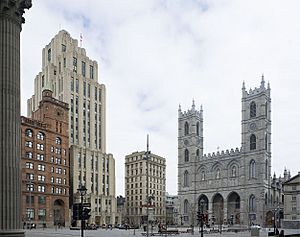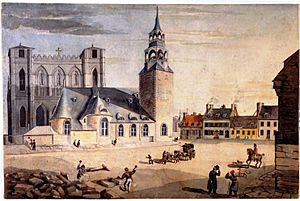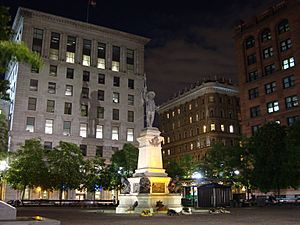Place d'Armes facts for kids
Quick facts for kids Place d'Armes |
|
|---|---|

Notre-Dame Basilica and Maisonneuve Monument viewed from Place d'Armes
|
|
| Lua error in Module:Location_map at line 420: attempt to index field 'wikibase' (a nil value). | |
| Type | Town square |
| Location | Old Montreal, Ville-Marie Montreal, Quebec, Canada |
| Created | 1836 |
| Operated by | City of Montreal |
| Status | Open all year |
| Public transit access | Place-d'Armes (Montreal Metro) |
Place d'Armes is a famous square located in Old Montreal, a historic part of Montreal, Quebec, Canada. In the middle of the square, you'll find a large monument honoring Paul Chomedey de Maisonneuve, who founded Montreal. Many important and historic buildings surround the square, including the beautiful Notre-Dame Basilica, the Saint-Sulpice Seminary, and the Bank of Montreal head office. Other notable buildings are the New York Life Building, the Aldred Building, and 500 Place D'Armes.
Contents
History of Place d'Armes
Place d'Armes is the second oldest public space in Montreal. It was first created in 1693 and was called Place de la Fabrique. This was done at the request of the Sulpicians, a religious group.
Later, in 1721, its name was changed to Place d'Armes. This new name came about because the square was used for different military events. From 1781 to 1813, it served as a market where hay and wood were sold. The city bought the square in 1836 and turned it into a lovely Victorian garden.
The square's size today is similar to a plan started in 1845 and finished in 1850. This was when Notre-Dame Street was completed. The square got its current size after the old Notre-Dame Church was taken down in 1830, and its bell tower in 1843.
Changes During the Great Depression
During the Great Depression, a time when many people struggled, Montreal's Mayor Camillien Houde started public building projects. One of these projects was a public restroom built under Place d'Armes in 1934. It was designed in the Art Deco style. This underground area was quite large, about 270 square meters. It had two granite entrances that let in natural light. The bathrooms also featured glass block windows, which were quite new for Montreal in the 1930s.
Modern Renovations of the Square
The square was updated in the 1960s. The way the square looked above ground stayed the same until 2009. The public restroom under the square became old and dirty by the 1940s. It was closed in 1980 for reasons of cleanliness.
The City of Montreal started renovating Place d'Armes again in late 2009. This work finished in 2011 and cost $15.5 million. During this renovation, workers found the old public restroom. They also found parts of the walls from the earlier Notre-Dame Church and a water well called the "Puits Gadbois."
Important Monuments
George III Monument
In 1773, a monument to King George III was put up in Place d'Armes. This was the first known public monument in Montreal. However, on May 1, 1775, the statue of George III was damaged. This act was a protest against the Quebec Act, which protected the use of the French language. A large reward was offered, but the person responsible was never caught. The monument disappeared soon after, during the American invasion of Montreal (1775–1776). It was later found at the bottom of a well in the square.
Maisonneuve Monument
Today, the square features a large monument dedicated to Paul Chomedey de Maisonneuve. This monument, created in 1895 by artist Louis-Philippe Hébert, remembers de Maisonneuve's efforts to protect the early French settlement. He defended it against the Iroquois, who were fighting against de Maisonneuve's allies, the Hurons. The foundations of the original Notre-Dame Church are still located beneath the square.
Buildings Around the Square
The buildings surrounding Place d'Armes show different important times in Montreal's history. The most famous buildings facing the square are the Notre-Dame Basilica and the Saint-Sulpice Seminary.
Other notable buildings include:
- The New York Life Building (built in 1887), which was Montreal's first tall building.
- The Bank of Montreal head office (built in 1859), which was Canada's first bank.
- The Art Deco Aldred Building (built in 1931).
- The International style 500 Place D'Armes (built in 1968).
How to Get There
Place d'Armes is located between Saint Jacques and Notre-Dame streets. It's a popular starting point for calèches, which are horse-drawn carriages offering tours of Old Montreal. The Metro station with the same name is just a short walk away.
There was a plan in 1801 to extend Place d'Armes down to Saint-Antoine Street. This would have given a better view of Notre-Dame Basilica, but it was never built. Instead, the square is connected to Saint-Antoine Street by a steep hill called Côte de la Place-d'Armes.
In the past, when Old Montreal and Saint-Jacques Street were the main downtown areas, Place d'Armes was a central spot for the city's tramway lines. A plan for the Montreal Metro in the 1940s included a station directly under the square for easy transfers. The current Metro station is a short distance north of the square.
What "Place d'Armes" Means
Place d'Armes is the third location in Montreal to have this name. It's a French term that has been used for a long time to describe a place where a city's defenders would gather.
See also
 In Spanish: Place d'Armes de Montreal para niños
In Spanish: Place d'Armes de Montreal para niños





